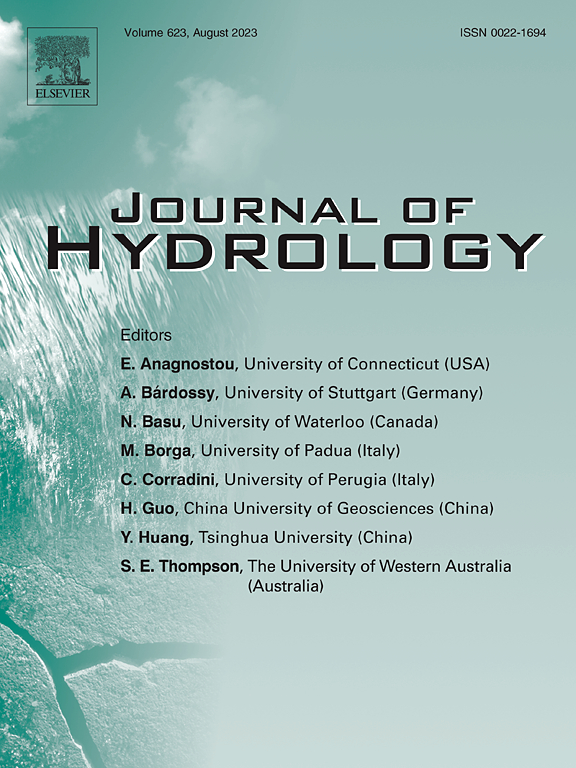通过PySR中符号回归的机器学习模型,探索了水流不稳定条件下河流动态级流量关系的新数学表达式
IF 5.9
1区 地球科学
Q1 ENGINEERING, CIVIL
引用次数: 0
摘要
由参数a和b定义的级流量(h-Q)等级曲线(Q = ahb)是测量河流流量的重要工具。然而,这种关系会受到流量波动、回水效应、潮汐和截面几何形状变化的影响,从而影响其准确性。机器学习(ML)算法以连续阶段作为输入对排放进行建模,捕获复杂的非线性关系,尽管它们的“黑箱”性质缺乏明确的数学表达式。因此,本研究旨在探索使用符号回归对阶段排放数据进行训练的ML模型,以生成阶段排放关系的实际数学表达式。通过使用顺序阶段数据作为自变量,捕获了不稳定对Churni河(印度)、Brays Bayou、Little Fishing Creek和Obion(美国)的阶段-流量关系的影响。采用PySR工具进行符号回归,推导数学表达式,建立基于机器学习的评级曲线模型。对于每条河流,通过符号回归得出了五个通用的数学表达式,其中流量被评估为连续阶段的动力项的多项式,而不是依赖于传统的关系。这些表达式根据其建模性能、预测准确性和物理相关性进行评估。结果表明,与传统关系相比,ML模型的决定系数显著提高了9-56 %。评价结果表明,新的级流量方程具有较好的性能,认识到该方程在河流断面上的独特的级流量关系数学框架,并建立了其推导方法。本研究执行符号回归的新应用,以评估有关顺序阶段和放电的显式数学表达式。本文章由计算机程序翻译,如有差异,请以英文原文为准。

Novel mathematical expression for dynamic stage-discharge relationship of Rivers under flow unsteadiness explored through machine learning models via symbolic regression in PySR
Stage-discharge (h-Q) rating curve (Q = ahb) defined by parameters a and b is a crucial tool for measuring riverflow. However, this relationship struggles with flow fluctuations, backwater effects, tides, and changes in cross-sectional geometry, impacting its accuracy. Machine learning (ML) algorithms model the discharge with sequential stages as input, capturing intricate non-linear relationships, despite their “black box” nature that lacks explicit mathematical expressions. This study aims, therefore, to explore ML models trained on stage-discharge data using symbolic regression to produce actual mathematical expressions for stage-discharge relationships. By using sequential stage data as independent variables, the effect of unsteadiness is captured on stage-discharge relationships for River Churni (in India), Brays Bayou, Little Fishing Creek, and Obion (in USA). Symbolic regression using PySR tool is newly implemented to derive the mathematical expressions, followed by ML-based rating curve models. For each river, five generic mathematical expressions have been derived through symbolic regression where discharge is evaluated as polynomials of powered terms of sequential stages, rather than relying on conventional relationships. These expressions are assessed based on their modeling performance, prediction accuracy, and physical relevance. The results indicate that the coefficient of determination has significantly increased by 9–56 % with ML models compared to conventional relationships. The evaluation results show the best performance of new stage-discharge equation, recognizing the unique mathematical framework of stage-discharge relationship at river cross-sections and establishing a methodology for deriving it. This study executes a novel application of symbolic regression to evaluate explicit mathematical expressions relating to the sequential stage and discharge.
求助全文
通过发布文献求助,成功后即可免费获取论文全文。
去求助
来源期刊

Journal of Hydrology
地学-地球科学综合
CiteScore
11.00
自引率
12.50%
发文量
1309
审稿时长
7.5 months
期刊介绍:
The Journal of Hydrology publishes original research papers and comprehensive reviews in all the subfields of the hydrological sciences including water based management and policy issues that impact on economics and society. These comprise, but are not limited to the physical, chemical, biogeochemical, stochastic and systems aspects of surface and groundwater hydrology, hydrometeorology and hydrogeology. Relevant topics incorporating the insights and methodologies of disciplines such as climatology, water resource systems, hydraulics, agrohydrology, geomorphology, soil science, instrumentation and remote sensing, civil and environmental engineering are included. Social science perspectives on hydrological problems such as resource and ecological economics, environmental sociology, psychology and behavioural science, management and policy analysis are also invited. Multi-and interdisciplinary analyses of hydrological problems are within scope. The science published in the Journal of Hydrology is relevant to catchment scales rather than exclusively to a local scale or site.
 求助内容:
求助内容: 应助结果提醒方式:
应助结果提醒方式:


